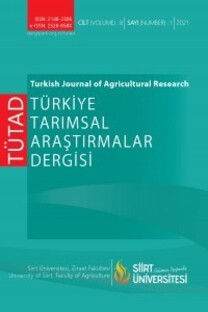Bazı Orkide Türlerinde Farklı Yöntemlerle İzole Edilen Funguslar
Birçok karasal orkide türü, tohumlarının çok küçük olması ve endosperm içermemesi sebebiyle, tohumlarınçimlenmesi ve bitkilerin yaşamlarına devam etmesi için mikorizal funguslara ihtiyaç duymaktadır. Çeşitli izolasyonyöntemlerinin yapılması ile elde edilen fungusların orkide türleri üzerindeki etkisini belirlemek; tohumların çimlenme vebitkilerin çoğalmalarına olanak sağlamak amacıyla simbiyotik kültür çalışmaları yapılmaktadır. Bu çalışmada Anacamptis,Cephalanthera, Dactylorhiza ve Orchis cinslerine ait on bir orkide türünün yumru ve rizomlarından bir; yetiştikleritopraklardan üç olmak üzere toplam dört izolasyon yöntemi denenmiş olup, yöntemlerde üç farklı kültür ortamıkullanılmıştır. Çalışmanın sonunda Alternaria, Aspergillus, Fusarium, Macrophomina, Rhizoctonia, Trichoderma veVerticillium fungusları izole edilmiştir. Özellikle Rhizoctonia spp. fungusunun izole edilmesinin hedeflendiği çalışmada,Rhizoctonia spp., Dactylorhiza umbrosa ve Orchis palustris türlerinin yumrularından; Orchis simia türünün ise toprağındanizole edilmiştir. Fusarium ve Aspergillus türleri tüm türlerde ve izlenen yöntemlerde en çok izole edilen funguslar olmuştur.
Due to their very small seeds that do not contain endosperm, many terrestrial orchid species require the presence of fungi in order to germinate and maintain their lives; and symbiotic culture studies are being carried out on this topic. For the purpose of determining the orchid species on which the fungus to be used as inoculants in the symbiotic culture will be effective, fungi isolated through several isolation methods are cultured with orchid species. In this study a total of four different isolation methods were applied as one on the tubers and rhizomes and three on the soil of eleven orchid species from the Anacamptis, Cephalanthera, Dactylorhiza and Orchis genera. Three different culture media were used in the methods. At the end of the study Alternaria, Aspergillus, Fusarium, Macrophomina, Rhizoctonia, Trichoderma and Verticillium fungi were isolated. In the study that was conducted with the aimed to isolate particularly Rhizoctania spp. fungi, the fungi was isolated from the tubers of Dactylorhiza umbrosa and Orchis palustris species and the soil of the Orchis simia species. Fusarium and Aspergillus species were isolated the most in all implemented methods and from all species
Keywords:
Fungi, isolation method, mycorrhiza, orchid, soil, tuber,
___
- Arditti, J., 1967. Factor affecting the germination of orchid seeds. Bot. Rev., 33:1-97.
- Bernard, N., 1909. L’evolution dans la symbiobe. Les orchideés et leurs champingnons commensaux. Ann. Sci. Nat. (Bot.), 9(9): 1-196.
- Burgeff, H., 1936. Die samenkeimung der orchideen. G. Fischer, Jea. 312.
- Chesters, C.G.C., 1949. Concerning fungi inhabiting soil. Trans. Brit. Mycol. Soc., 32:197-216.
- Clements, M.A., Muir, H., Cribb, P.J., 1986. A preliminary report on the symbiotic germination of Europe an terrestrial orchids. Kew. Bull, 41(2): 437- 445.
- Curtis, J.T., 1939. The relation of specificity of orchid mycorrhizal fungi to the problem of symbiosis. Amer. J. Bot., 26: 390-399.
- Çığ, A., 2012. Van’da doğal olarak yetişen salep orkidelerinin simbiyotik ve asimbiyotik olarak in vitro ve in vivo ortamlarda çoğaltılması. Doktora tezi, Yüzüncü Yıl Üniversitesi, Fen Bilimleri Enstitüsü, Van.
- Davis, P.H., 1984. Flora of Turkey and the East Aegan Islands. Volume: 8, Edinburg University Press, Great Britain.
- Ekim, T., Koyuncu, M., Vural, M., Duman, H., Aytaç, Z., Adıgüzel, N., 2000. Türkiye Bitkileri Kırmızı Kitabı, Yayın No: 18, Ankara.
- Gezgin, Y., 2004. Çeşitli salep (orkide) türlerinde mikoriza oluşturan fungusların izolasyonu ve tanımlanması ile inokulant olarak kullanım olanaklarının incelenmesi. Yüksek lisans tezi, Ege Üniversitesi, Fen Bilimleri Enstitüsü, İzmir.
- Hadley, G., 1983. Symbiotic germination of orchid seed. The Orchid Review, February, 44-47.
- Harvais, G., Hadley, G., 1967. The relation between host and endophyte in orchid mycorrhiza. New Phytol., 66:205-215.
- Hasenekoğlu, İ., 1991. Toprak Mikro Fungusları. Atatürk Üniversitesi Yayınları, No: 689, Kazım Karabekir Eğitim Fakültesi Yayınları No: 11, Cilt: IV-VI. Erzurum.
- Hayakawa, S., Uetake, Y., Ogoshi, A., 1999. Identification of symbiotic Rhizoctonias from naturally occurring protocorms and roots of Dactylorhiza aristata (Orchidaceae). J. Fac. Agr. Hokkaido Univ., 69(2): 129-141.
- İşler, S., 2005. Van salebinin menşei ve Van civarının orkideleri. Doktora tezi, Yüzüncü Yıl Üniversitesi, Fen Bilimleri Enstitüsü, Van.
- Koyuncu, M., Demirkuş, N., 2000. Van çevresi geofitleri. (Uluslararası Katılımlı), 05-09 Eylül 1999, Ankara.
- Madigan, M.T., Martinko, J.M., Parker, J., 2003. Brock- Biology of Microorganisms. 10th ed., Prentice Hall Inc., ISBN 0-13-085264-3.
- Masuhara, G., Kimura, S., Katsuya, K., 1988. Seasonal changes in the myccorrhizae of Bletilla striata (Orchidaceae). Trans. Mycol. Soc. Japan., 29:25-31.
- Ortaş, İ., 2011. Orkide mikorizasının bitki çimlenmesi ve gelişimi üzerine etkisi. I. Salep Orkidesi Çalıştayı, 24-25 Mayıs, Kahramanmaraş, s. 39-64.
- Özkoç, İ., 1991. Serapias vomeracea (Burm fil.) Briq. subsp. laxiflora (Soo) Gölz et. Reinhard ve Orchis laxiflora simbiyotik ve asimbiyotik kültürlerde çimlenme ve gelişmesi üzerinde araştırılması. Doktora tezi, Ondokuz Mayıs Üniversitesi, Fen Bilimleri Enstitüsü, Samsun. tohumlarının
- Papavizas, G.C., Adams, P.B., Lumsden, R.D., Lewis, J.A., Dow, R.L., Ayers, W.A., Kantzes, J.G., 1975. Ecology and epidermiology of Rhizoctonia solani in field soil. Phytopathology, 65: 871-877.
- Roberts, D.L., Herr, L.S., 1979. Superiority of a soil debris isolation method over a beet seed colonization method for assay of Rhizoctonia solani at high soil inoculum densities. Can. L. Microbial, 25: 1110- 1113.
- Sezik, E., 1984. Orkidelerimiz, Türkiye’nin Orkideleri. Sandoz Kültür Yayınları, No: 6, 166.
- Vakkasoğlu, F., 1995. Orkidelerde mikorizal fungusların orkide tohumlarının çimlenmesi ve büyümeleri üzerine etkisi. Yüksek lisans tezi, Çukurova Üniversitesi, Fen Bilimleri Enstitüsü, Adana.
- ISSN: 2148-2306
- Başlangıç: 2014
- Yayıncı: SİİRT ÜNİVERSİTESİ ZİRAAT FAKÜLTESİ
Sayıdaki Diğer Makaleler
Some Orchid Species Fungi Isolated by Different Methods
Sofralık ve Kurutmalık İncir Kalite Kriterleri ve Kaliteyi Etkileyen Faktörler
Arzu GÖÇMEZ, Halil Güner SEFEROĞLU
Agricultural Meteorological Properties of Aras Basin in Turkey
Antalya'nın Kepez İlçesinde Geleneksel Sera Üretiminin Özellikleri
Uğur GALE, Yüksel TÜZEL, Gölgen Bahar ÖZTEKİN
Abdulkadir SÜRÜCÜ, Meryem GÜNEŞ, Alaaddin YÜKSEL, Ali Rıza DEMİRKIRAN, Selami KAYA
Orhan DENGİZ, İnci DEMİRAĞ TURAN
Van İlinde Kaba Yem Üretim Potansiyeli, Sorunlar ve Çözüm Önerileri
Nizamettin TURAN, Fevzi ALTUNER
Bazı Orkide Türlerinde Farklı Yöntemlerle İzole Edilen Funguslar
